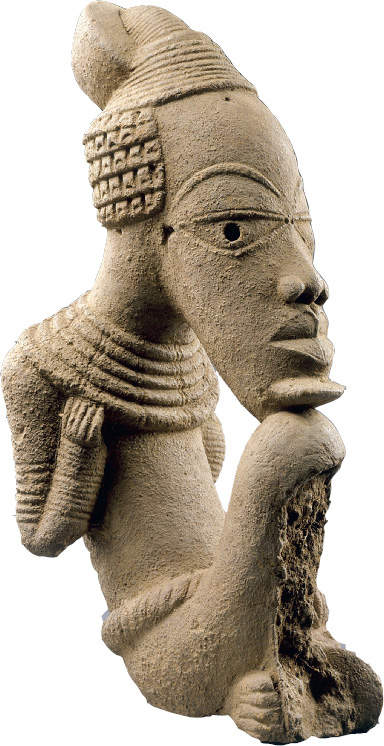The Culture of Agriculture
What did that future look like? In what ways did societies based on the domestication of plants and animals differ from those rooted in a gathering and hunting economy? In the first place, the Agricultural Revolution led to an increase in human population, as the greater productivity of agriculture was able to support much larger numbers. An early agricultural settlement uncovered near Jericho in present-day Israel probably had 2,000 people, a vast increase in the size of human communities compared to much smaller Paleolithic bands. On a global level, scholars estimate that the world’s population was about 6 million around 10,000 years ago, before the Agricultural Revolution got underway, and shot up to some 50 million by 5,000 years ago and 250 million by the beginning of the Common Era. Here was the real beginning of the human dominance over other forms of life on the planet.
That dominance was reflected in major environmental transformations. In a growing number of places, forests and grasslands became cultivated fields and grazing lands. Human selection modified the genetic composition of numerous plants and animals. In parts of the Middle East within a thousand years after the beginning of settled agricultural life, some villages were abandoned when soil erosion and deforestation led to declining crop yields, which could not support mounting populations.25 The advent of more intensive agriculture associated with city-based civilizations only heightened this human impact on the landscape.

Human life too changed dramatically in farming communities, and not necessarily for the better. Farming involved hard work and more of it than in many earlier gathering and hunting societies. The remains of early agricultural people show some deterioration in health—more tooth decay, malnutrition, and anemia, a shorter physical stature, and diminished life expectancy. Living close to animals subjected humans to new diseases—smallpox, flu, measles, chicken pox, malaria, tuberculosis, rabies—while living in larger communities generated epidemics for the first time in human history. Furthermore, relying on a small number of plants or animals rendered early agricultural societies vulnerable to famine, in case of crop failure, drought, or other catastrophes. The advent of agriculture bore costs as well as benefits.
Agriculture also imposed constraints on human communities. Some Paleolithic people had settled in permanent villages, but all agricultural people did so, as farming required a settled life. A good example of an early agricultural settlement comes from northern China, one of the original independent sources of agriculture, where the domestication of rice, millet, pigs, and chickens gave rise to settled communities by about 7,000 years ago. In 1953, workers digging the foundation for a factory uncovered the remains of an ancient village, now called Banpo, near the present-day city of Xian. Millet, pigs, and dogs had been domesticated, but diets were supplemented with wild plants, animals, and fish. Some forty-five houses covered with thatch laid over wooden beams provided homes to perhaps 500 people. More than 200 storage pits permitted the accumulation of grain, and six kilns and pottery wheels enabled the production of various pots, vases, and dishes, many decorated with geometric designs and human and animal images. A large central space suggests an area for public religious or political activity, and a trench surrounding the village indicates some common effort to defend the community.
Early agricultural villages such as Banpo reveal another feature of the age of agriculture—an explosion of technological innovation. Mobile Paleolithic peoples had little use for pots, but such vessels were essential for settled societies, and their creation and elaboration accompanied agriculture everywhere. So too did the weaving of textiles, made possible by collecting the fibers of domesticated plants (cotton and flax, for example) and raising animals such as sheep. Evidence for the invention of looms of several kinds dates back to 7,000 years ago, and textiles, some elaborately decorated, show up in Peru, Switzerland, China, and Egypt. Like agriculture itself, weaving was a technology in which women were probably the primary innovators. It was a task that was compatible with child-rearing responsibilities, which virtually all human societies assigned primarily to women.26 Another technology associated with the Agricultural Revolution was metallurgy. The working of gold and copper, then bronze, and, later, iron became part of the jewelry-, tool-, and weapon-making skill set of humankind. The long “stone age” of human technological history was coming to an end, and the age of metals was beginning.
A further set of technological changes, beginning around 4000 B.C.E., has been labeled the “secondary products revolution.”27 These technological innovations involved new uses for domesticated animals, beyond their meat and hides. Agricultural people in parts of Europe, Asia, and Africa learned to milk their animals, to harvest their wool, and to enrich the soil with their manure. Even more important, they learned to ride horses and camels and to hitch various animals to plows and carts. Because these animals did not exist in the Americas, this revolutionary new source of power and transportation was available only in the Eastern Hemisphere.
Finally the Agricultural Revolution presented to humankind the gift of wine and beer, often a blessing, sometimes a curse. As barley, wheat, rice, and grapes were domesticated, their potential for generating alcoholic beverages was soon discovered. Evidence for wine making in the mountains of present-day northwestern Iran dates to around 5400 B.C.E., though its expense rendered it an elite beverage for millennia. Chinese wine making can be traced to around 4000 B.C.E. Drunken debauchery and carousing among the aristocracy prompted an unsuccessful effort by one Chinese ruler around 1046 B.C.E. to outlaw the beverage. The precise origins of beer are unclear, but its use was already quite widespread in the Middle East by 4000 B.C.E., when a pictogram on a seal from Mesopotamia showed two figures using straws to drink beer from a large pottery jar. Regarded as a gift from the gods, beer, like bread, was understood in Mesopotamia as something that could turn a savage into a fully human and civilized person.28